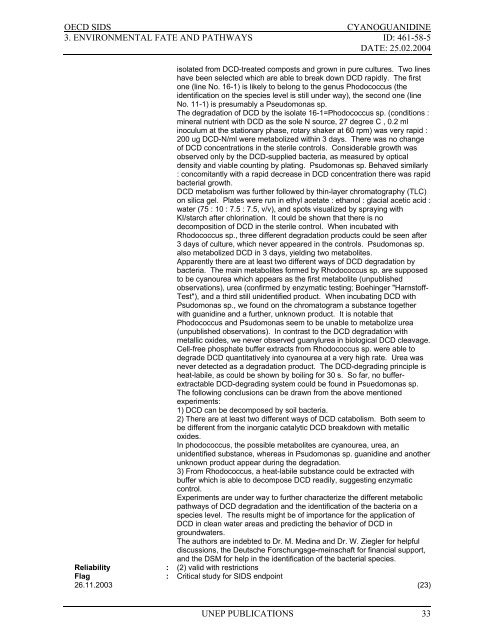Cyanoguanidine CAS N°: 461-58-5
Cyanoguanidine CAS N°: 461-58-5
Cyanoguanidine CAS N°: 461-58-5
You also want an ePaper? Increase the reach of your titles
YUMPU automatically turns print PDFs into web optimized ePapers that Google loves.
OECD SIDS<br />
CYANOGUANIDINE<br />
3. ENVIRONMENTAL FATE AND PATHWAYS ID: <strong>461</strong>-<strong>58</strong>-5<br />
DATE: 25.02.2004<br />
isolated from DCD-treated composts and grown in pure cultures. Two lines<br />
have been selected which are able to break down DCD rapidly. The first<br />
one (line No. 16-1) is likely to belong to the genus Phodococcus (the<br />
identification on the species level is still under way), the second one (line<br />
No. 11-1) is presumably a Pseudomonas sp.<br />
The degradation of DCD by the isolate 16-1=Phodococcus sp. (conditions :<br />
mineral nutrient with DCD as the sole N source, 27 degree C , 0.2 ml<br />
inoculum at the stationary phase, rotary shaker at 60 rpm) was very rapid :<br />
200 ug DCD-N/ml were metabolized within 3 days. There was no change<br />
of DCD concentrations in the sterile controls. Considerable growth was<br />
observed only by the DCD-supplied bacteria, as measured by optical<br />
density and viable counting by plating. Psudomonas sp. Behaved similarly<br />
: concomitantly with a rapid decrease in DCD concentration there was rapid<br />
bacterial growth.<br />
DCD metabolism was further followed by thin-layer chromatography (TLC)<br />
on silica gel. Plates were run in ethyl acetate : ethanol : glacial acetic acid :<br />
water (75 : 10 : 7.5 : 7.5, v/v), and spots visualized by spraying with<br />
KI/starch after chlorination. It could be shown that there is no<br />
decomposition of DCD in the sterile control. When incubated with<br />
Rhodococcus sp., three different degradation products could be seen after<br />
3 days of culture, which never appeared in the controls. Psudomonas sp.<br />
also metabolized DCD in 3 days, yielding two metabolites.<br />
Apparently there are at least two different ways of DCD degradation by<br />
bacteria. The main metabolites formed by Rhodococcus sp. are supposed<br />
to be cyanourea which appears as the first metabolite (unpublished<br />
observations), urea (confirmed by enzymatic testing; Boehinger "Harnstoff-<br />
Test"), and a third still unidentified product. When incubating DCD with<br />
Psudomonas sp., we found on the chromatogram a substance together<br />
with guanidine and a further, unknown product. It is notable that<br />
Phodococcus and Psudomonas seem to be unable to metabolize urea<br />
(unpublished observations). In contrast to the DCD degradation with<br />
metallic oxides, we never observed guanylurea in biological DCD cleavage.<br />
Cell-free phosphate buffer extracts from Rhodococcus sp. were able to<br />
degrade DCD quantitatively into cyanourea at a very high rate. Urea was<br />
never detected as a degradation product. The DCD-degrading principle is<br />
heat-labile, as could be shown by boiling for 30 s. So far, no bufferextractable<br />
DCD-degrading system could be found in Psuedomonas sp.<br />
The following conclusions can be drawn from the above mentioned<br />
experiments:<br />
1) DCD can be decomposed by soil bacteria.<br />
2) There are at least two different ways of DCD catabolism. Both seem to<br />
be different from the inorganic catalytic DCD breakdown with metallic<br />
oxides.<br />
In phodococcus, the possible metabolites are cyanourea, urea, an<br />
unidentified substance, whereas in Psudomonas sp. guanidine and another<br />
unknown product appear during the degradation.<br />
3) From Rhodococcus, a heat-labile substance could be extracted with<br />
buffer which is able to decompose DCD readily, suggesting enzymatic<br />
control.<br />
Experiments are under way to further characterize the different metabolic<br />
pathways of DCD degradation and the identification of the bacteria on a<br />
species level. The results might be of importance for the application of<br />
DCD in clean water areas and predicting the behavior of DCD in<br />
groundwaters.<br />
The authors are indebted to Dr. M. Medina and Dr. W. Ziegler for helpful<br />
discussions, the Deutsche Forschungsge-meinschaft for financial support,<br />
and the DSM for help in the identification of the bacterial species.<br />
Reliability : (2) valid with restrictions<br />
Flag : Critical study for SIDS endpoint<br />
26.11.2003 (23)<br />
UNEP PUBLICATIONS 33
















